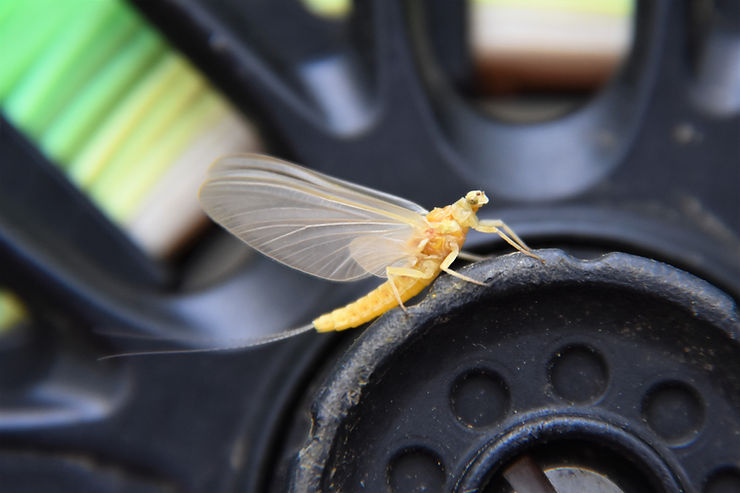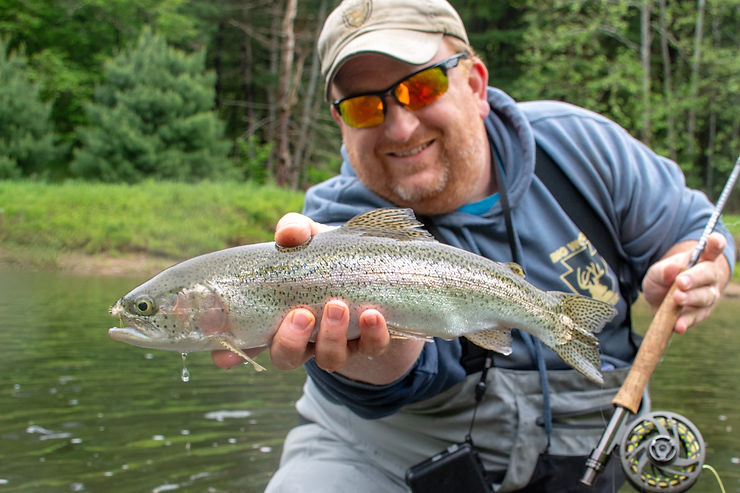Sulphurs in the Rain

Memorial Day Weekend started with a hard rain that brought the streams up to normal levels. In fact, over the years, I can recall more Memorial Day Weekends with rain than I can without. One thing I know for sure, though: rain or no rain, Memorial Day Weekend has always been one of my favorite times to fish. The combination of water temperature and bug activity means trout are almost always feeding heavily, and this year was no different.
My wife, two kids, and two dogs and I headed to camp in Potter County on Saturday morning. Fortunately, it was still raining, so I didn’t have to cut the grass. Not that I would’ve cut it then anyway. It’s a task I don’t particularly enjoy. Often, while cutting grass, I ask myself, “Who’s idea was this anyway?” Surely the idea of a neat lawn was devised by a non-fisherman, because nobody in their right mind who loves to fish would ever plant something that grows the fastest and requires the most attention during those times when fishing is at its best!
We got the kids and dogs settled in at camp just as the rain began to lighten up. So while my 4-year-old daughter lobbied to watch Spider-Man for the zillionth time, which is her tradition at camp, I headed down to the Delayed Harvest section of First Fork Sinnemahoning Creek to see if any bugs were coming off.
Even in today’s world of knowledge-sharing on social media, where fly shops and individuals post daily updates about fly hatches and activity on certain streams, it’s still difficult to hit the ideal situation. “You should’ve been here yesterday” perfectly describes most fly fishing experiences. Timing a hatch is a fickle hobby. More often than not, you’re either too late or too early, sometimes by days and sometimes by merely hours.
It’s seldom you roll up to a stream just as the thickest hatch of Sulphurs you’ve ever seen starts coming off and every trout in the pool immediately starts rising for them. But that’s exactly what happened that afternoon, and I couldn’t get my waders on fast enough, and it took me three attempts to string my fly line through my rod guides because my hands were shaking so much.
The most interesting part of the scene, though, was the overall lack of other fishermen. When we’d driven up earlier that morning, when it was raining harder than it was now, the Delayed Harvest was crawling with people. But now that the rain had subsided into a steady mist, most of the cars were gone and only a handful of fishermen were spread out over several hundred yards of stream.
I finally got my act together and slipped over the guardrail and climbed down the hillside to the water. Big, beautiful Sulphur duns floated down like sailboats. There were a lot of them but not too many that you couldn’t focus on a single insect and watch it ride down in the current, and then watch a trout come up for it.
Sulphurs are an interesting mayfly. They’re perhaps the most abundant mayfly found in Eastern streams and rivers, thriving in both coldwater and warmwater environments.
Sulphurs generally begin hatching in early- to mid-May most years – although I read reports of them hatching even earlier this year on some waters – and continue through early June (later on northern streams). There are two main species of Sulphur, Ephemerella invaria and Ephemerella dorothea, and it can be difficult to decipher one from the other, although invaria is generally size 14-16 while dorothea is more like a size 18. Also, invaria is the first to appear early in the season and dorothea hatches later in the season.
Several factors can make the Sulphurs a challenge to fish. First, there’s a lot of variation in fly coloration from stream to stream. A Sulphur imitation that’s deadly on one stream may be totally useless on another. They can range in color from yellow to orange to olive, and I have no idea why.
Second, although the emerging process can take some time, once they reach dun stage, they don’t waste time taking flight. It’s rare to see a ton of duns on the water at one time. About the only time I’ve experienced it is when it’s raining during the hatch. Generally speaking, the most consistent surface action occurs during the spinner fall portion of a Sulphur hatch very late in the evening.
Third, other insects often emerge at the same time as Sulphurs, and it can be difficult determining which species the trout are actually keying on. Add in the fact that there can also be two different sizes of Sulphurs present at the same time, and matching the hatch can be a crapshoot.
Fourth, because Sulphur duns don’t spend much time on the water, you can usually catch more fish during this hatch by fishing an emerger or soft hackle pattern. In fact, an effective tactic is to lather up a size 16 or 18 Sulphur Soft Hackle Emerger with dry fly floatant and fish it on the surface or in the film rather than drift or swing it like a traditional wet fly.
This past weekend, I experienced a little bit of all of these factors. Two different sizes of Sulphurs were on the water. Multiple insects were coming off (Blue-Winged Olives, Gray Foxes, and Sulphurs, in this case). And the rain was just hard enough to keep the duns on the water long enough for the trout to eat. And although I witnessed individual trout feeding on multiple species of insects, they turned oddly selective once I drifted a fly over their heads.
Despite multiple refusals, I didn’t switch from the orange-bodied imitation that I usually do well with during Sulphur hatches. Instead, I lengthened my tippet and dropped down from 5x to 6x. While our initial instinct is to think that we’re just not using the correct imitation to match the hatch, more often it’s our presentation that needs fixed.
This particular stretch of stream was a long, slow pool where trout had lots of time to study a fly. When you combine that with the fact that this was Delayed Harvest and had been fished hard all season, as well as earlier that day, and you can see why trout can get finicky about how a fly is delivered.
After changing up my tippet, I caught trout on pretty much every drag-free drift. The operative phrase there, of course, is “drag-free.” I had to mend line a lot and utilize a reach cast that helped put the fly over the fish first rather than the leader and tippet.

The Sulphurs came off heavy for a couple of hours and trout gorged on them. Eventually the rain stopped, the wind picked up, and there was a noticeable drop in temperature and bug activity. The lull lasted an hour or so, and during that time I picked up a few stragglers on a size 20 Mole Fly.
Around 7:30, Light Cahills started emerging and I even spotted a few Green Drakes. I fished until dark, long enough to lose count of how many trout I’d caught.
I visited a different section of stream on Sunday and encountered completely different conditions and not as much bug activity. It’s not uncommon for things to be a little slow following a day or two of intense hatches. It was also a reminder to appreciate those times when the stars align and I find myself in the right place at the right time.
So when Monday morning dawned sunny and warm with a cloudless blue sky (exactly the kind of day when the fishing is usually slow), I took advantage of the beautiful weather and cut the grass before heading home. Maybe that’s where that old adage “make hay while the sun’s shining” comes from. Maybe the farmer who first said that was a fly fisherman who knew that a good rain was great for crops – and mayfly hatches.
Sign up for the Dark Skies Fly Fishing e-newsletter
It's free, delivered to your inbox approximately three times each month. Your information is always kept private and used for the sole purpose of keeping you up to date on blog posts and specials in the online store.
Sign Up Now